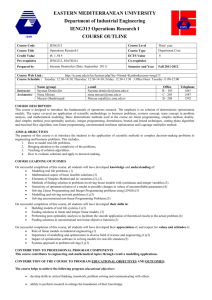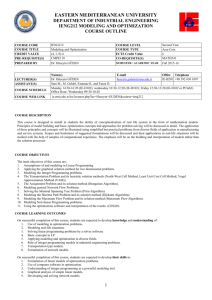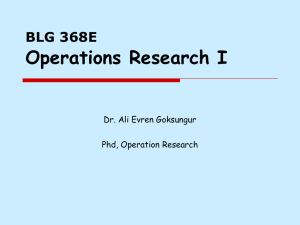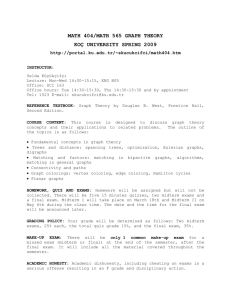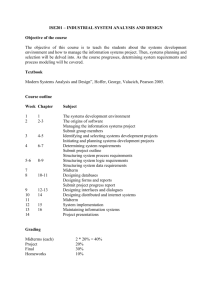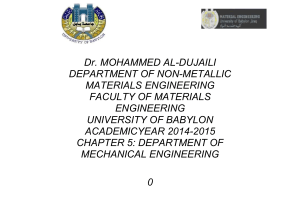Dowload File - Industrial Engineering Department EMU-DAU
advertisement
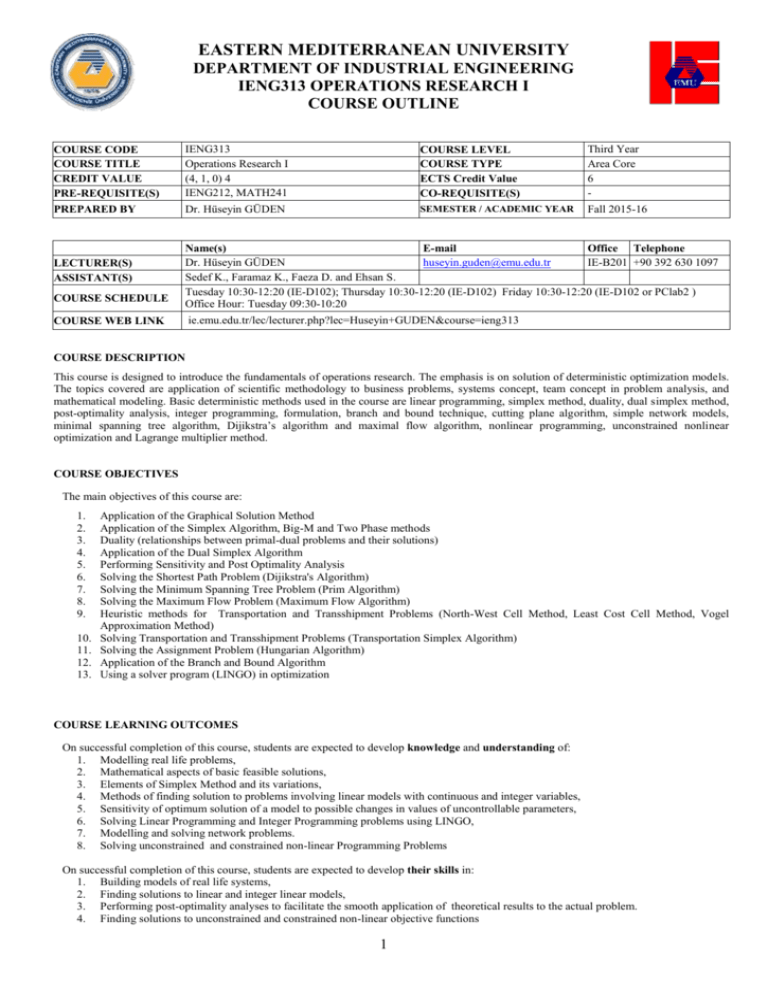
EASTERN MEDITERRANEAN UNIVERSITY DEPARTMENT OF INDUSTRIAL ENGINEERING IENG313 OPERATIONS RESEARCH I COURSE OUTLINE COURSE CODE COURSE TITLE CREDIT VALUE PRE-REQUISITE(S) IENG313 Operations Research I (4, 1, 0) 4 IENG212, MATH241 COURSE LEVEL COURSE TYPE ECTS Credit Value CO-REQUISITE(S) Third Year Area Core 6 - PREPARED BY Dr. Hüseyin GÜDEN SEMESTER / ACADEMIC YEAR Fall 2015-16 LECTURER(S) ASSISTANT(S) COURSE SCHEDULE Name(s) E-mail Office Telephone Dr. Hüseyin GÜDEN huseyin.guden@emu.edu.tr IE-B201 +90 392 630 1097 Sedef K., Faramaz K., Faeza D. and Ehsan S. Tuesday 10:30-12:20 (IE-D102); Thursday 10:30-12:20 (IE-D102) Friday 10:30-12:20 (IE-D102 or PClab2 ) Office Hour: Tuesday 09:30-10:20 COURSE WEB LINK ie.emu.edu.tr/lec/lecturer.php?lec=Huseyin+GUDEN&course=ieng313 COURSE DESCRIPTION This course is designed to introduce the fundamentals of operations research. The emphasis is on solution of deterministic optimization models. The topics covered are application of scientific methodology to business problems, systems concept, team concept in problem analysis, and mathematical modeling. Basic deterministic methods used in the course are linear programming, simplex method, duality, dual simplex method, post-optimality analysis, integer programming, formulation, branch and bound technique, cutting plane algorithm, simple network models, minimal spanning tree algorithm, Dijikstra’s algorithm and maximal flow algorithm, nonlinear programming, unconstrained nonlinear optimization and Lagrange multiplier method. COURSE OBJECTIVES The main objectives of this course are: 1. 2. 3. 4. 5. 6. 7. 8. 9. 10. 11. 12. 13. Application of the Graphical Solution Method Application of the Simplex Algorithm, Big-M and Two Phase methods Duality (relationships between primal-dual problems and their solutions) Application of the Dual Simplex Algorithm Performing Sensitivity and Post Optimality Analysis Solving the Shortest Path Problem (Dijikstra's Algorithm) Solving the Minimum Spanning Tree Problem (Prim Algorithm) Solving the Maximum Flow Problem (Maximum Flow Algorithm) Heuristic methods for Transportation and Transshipment Problems (North-West Cell Method, Least Cost Cell Method, Vogel Approximation Method) Solving Transportation and Transshipment Problems (Transportation Simplex Algorithm) Solving the Assignment Problem (Hungarian Algorithm) Application of the Branch and Bound Algorithm Using a solver program (LINGO) in optimization COURSE LEARNING OUTCOMES On successful completion of this course, students are expected to develop knowledge and understanding of: 1. Modelling real life problems, 2. Mathematical aspects of basic feasible solutions, 3. Elements of Simplex Method and its variations, 4. Methods of finding solution to problems involving linear models with continuous and integer variables, 5. Sensitivity of optimum solution of a model to possible changes in values of uncontrollable parameters, 6. Solving Linear Programming and Integer Programming problems using LINGO, 7. Modelling and solving network problems. 8. Solving unconstrained and constrained non-linear Programming Problems On successful completion of this course, students are expected to develop their skills in: 1. Building models of real life systems, 2. Finding solutions to linear and integer linear models, 3. Performing post-optimality analyses to facilitate the smooth application of theoretical results to the actual problem. 4. Finding solutions to unconstrained and constrained non-linear objective functions 1 On successful completion of this course, students are expected to develop their appreciation of and respect for values and attitudes regarding the issues of: 1. Role of linear models in industrial engineering, 2. Importance of modeling and optimization in diverse fields of sciences and engineering, 3. Impact of optimization software in solving models for real-life situations, 4. Systems approach to problem solving. CONTRIBUTION OF THE COURSE TO MEETING THE REQUIREMENTS OF CRITERION 5 Mathematics and Basic Sciences Engineering Science Engineering Design General Education : 25 % : 25 % : 50 % : 0% RELATIONSHIP OF COURSE TO STUDENT OUTCOMES Level of Contribution Student Outcomes Moderate High NO (a) an ability to apply knowledge of mathematics, science and engineering (b) an ability to design and conduct experiments, as well as to analyze and interpret data (c) an ability to design a system, component, or process to meet desired needs within realistic constraints such as economic, environmental, social, political, ethical, health and safety, manufacturability, and sustainability (d) an ability to function on multi-disciplinary teams (e) an ability to identify, formulate, and solve engineering problems (f) an understanding of professional and ethical responsibility (g) an ability to communicate effectively (h) the broad education necessary to understand the impact of engineering solutions in a global, economic, environmental, and societal context (i) a recognition of the need for, and an ability to engage in life-long learning (j) a knowledge of contemporary issues (k) an ability to use the techniques, skills, and modern engineering tools necessary for engineering practice GRADING CRITERIA Exams: All examinations will be based on lectures, tutorials, labs, assigned readings, project study or other work. To pass these exams students will need to have studied the material well in advance in order to understand the concepts, procedures and techniques. To discourage last minute cramming, the instructor and the assistants will not answer any questions from students on the day of an examination. Exams may be closed book/note type or open book/note type or both type. The type of an exam will be announced just before starting it. Students should bring their notes/books and calculators to exams considering the possibility of using them. Exam results will be announced on the notice boards as soon as the exam papers have been evaluated. Descriptions of these examinations are as follows: Assignments: There will be 2 assignments. All necessary explanations will be made in advance. Quizzes: There will be 6 quizzes that will be announced in advance. 2 Midterm Exam: There will be one midterm examination that covers all the material up to the date of the examination. It will be scheduled for a day in the designated mid-term exams week. Final Exam: The final examination will cover all the material studied throughout the semester and has the same structure as in the midterm examination. Like the midterm exam, the final exam will be scheduled for a day in the designated final exams week. Make-up Exam: No make-up examination will be given to students who miss quizzes, and whose attendance is below 70%. Make-up examination will only be offered to students who missed the final or midterm exam and provided adequate documentations for the reason for their absence within three working days at the latest after the examination date. A student’s illness will only be accepted as a valid excuse if it is supported by a written report of a physician from the Health Center of the EMU. Note: The students may need a calculator so they should bring their calculators to all lecture/tutorial/lab/exam hours. RELATIONSHIP WITH OTHER COURSES It is a synthesis course of all the previously taken departmental courses and also co-requisite course for the course IENG343. LEARNING / TEACHING METHOD The instructor will lecture in class by writing on the board and using computer presentations. Several examples will be covered and discussed in detail by the lecturer in the classroom. To get a hands on experience, lectures will be supplimented by tutorials and lab sessions. The function of teaching is to enable students to learn. Therefore students are required to study from the declared books and other operations research books. Students are expected to use the library and internet in their searches and studies. ASSIGNMENTS There will be some reading, studying and application assignments, which will support the lectures. For any type of examination, students are also responsible from studying all assigned materials, even if they might not be discussed in class. METHOD OF ASSESSMENT Although the student’s overall grade will be based on the general assessment of the instructor, the following percentages may give an idea about the relative importance of various assessment tools. Attendance 5% Quizzes Assignments Mid-term Exam Final Exam TOTAL 30 5 30 30 100 % % % % points Note that the attendance Marks will be given according to the following intervals: Attendance Less than 70 % [70-75) % [75-80) % [80-85) % [85-90) % More than 90 % Mark 0 1 2 3 4 5 Note that the instructor reserves the right to modify these percentages in case he finds it necessary. Letter grade equivalents of numerical performances will be announced by the Registrar’s Office after the last day for the submission of letter grades. NG (Nil-grade): Conditions that lead to NG (Nil-grade): 1. Not attending the Final Exam or its Make-up Exam without a valid excuse. 2. Not attending the Mid-term Exam without a valid excuse. 3. Having an attendance to lectures/tutorials/labs less than 70%. Objections: Any form of document concerning work that is to be used by the instructor as the basis of grading will be shown to the student upon request, within a week following the announcement of the grade. The objection to any grade must be made to the assistants within that period. If, after an exam has been graded, you think an error was made in grading or you have questions about the grading of the material, please examine the exam solutions first, and then write your questions or comments on a separate sheet of paper and turn this paper to the assistants. 3 ATTENDANCE AND NG GRADE Attendance will be taken every Lecture/Tutorial/Lab session. Note that EMU regulations allow instructors to give a grade of NG (Nil Grade) to a student whose absenteeism is more than 30% of the Lecture/Tutorial/Lab hours and/or who do not complete sufficient work that are included in the assessment of the course. TEXTBOOK/S Students must have the following textbook: WINSTON, Wayne L., “Operations Research: Applications and Algorithms” 3rd edition, Duxbury Press 1993. ISBN: 0-534-20971-8. INDICATIVE BASIC READING LIST BAZARAA, M., “Linear Programming and Network Flows” 4 th edition, Wiley, 2010. ISBN:978-0470-46272-0. Taha, Hamdy A., “ Operations Research”, 6th international edition, Prentice Hall 1997; Hillier, F.S. and G.J. Lieberman, “Introduction to Operations Research”, 7th international edition, McGraw Hill 2001; Beltrami, Edward J., “Models for Public Systems Analysis ”, Academic Press 1977 “LINGO”, LINDO Systems Inc. BENDER, Edward, “An Introduction to Mathematical Modelling”, Dover Ed.,Dover Publications,2000 EXTENDED READING LIST Note that aside from these books, EMU Library has quite a good collection of books on the intermediate and advanced levels in the related fields of industrial engineering discipline. TOPICS COVERED and COURSE SCHEDULE WEEK 1 2 3 4 5 6 7 8 9 10 11 12 13 14 TOPICS Introduction to OR, Graphical Solution Method Basics of the Simplex Algorithm. Simplex Algorithm Two Phase and Big M methods Duality Dual Simplex Algorithm Sensitivity and Post optimality Analysis MIDTERM EXAM WEEK Sensitivity and Post optimality Analysis The Shortest Path Problem, Dijikstra’s Algorithm, The minimum spanning tree problem, Prim Algorithm Maximum Flow Algorithm, The Transportation Problem The Transportation Problem, The Assignment Problem Integer programming, Branch and bound algorithm Non-linear programming, Unconstrained Optimization ACADEMIC HONESTY, PLAGIARISM & CHEATING This is intentionally failing to give credit to sources used in writing regardless of whether they are published or unpublished. Plagiarism (which also includes any kind of cheating in exams) is a disciplinary offence and will be dealt with accordingly. According to university by laws cheating and plagiarism are serious offences punishable with disciplinary action ranging from simple failure from the exam or project/report, to more serious action (suspension from the university for up to one semester). Disciplinary action is written in student records and may appear in student transcripts. Any act not suitable for a university student will not be tolerated and may lead to formal disciplinary action. Example of this are: getting someone else to take the examinations for you, misrepresentation of your own answer sheet as another’s work, cheating, knowingly assisting other students to cheat, abusing the tolerance or breaking the discipline of the class. PLEASE KEEP THIS COURSE OUTLINE FOR FUTURE REFERENCE AS IT CONTAINS IMPORTANT INFORMATION!!! 4
